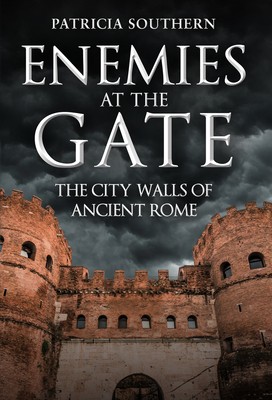
- We will send in 10–14 business days.
- Author: Patricia Southern
- Publisher: Amberley Publishing
- ISBN-10: 1398112976
- ISBN-13: 9781398112971
- Format: 16.6 x 23.8 x 4.1 cm, kieti viršeliai
- Language: English
- SAVE -10% with code: EXTRA
Reviews
Description
The earliest known wall in Rome encircled the early settlement on the Palatine Hill. It was built of pressed clay supported by a series of upright wooden posts, and archaeological evidence corroborates the traditional date of the foundation of the city in the eighth century BC. No new wall is known until the early sixth century BC, when King Servius Tullius built the defences named after him. Physical remains of an early wall are still visible in Rome, but there is no incontestable archaeological proof as to its date. The growth of the Empire, and the erection of solid frontiers by the Emperor Hadrian, obviated the need for walls around Rome until the troubles of the third century AD, when invading tribes crossed the frontiers. Defensive walls were built around several Roman cities, and in AD 274 the Emperor Aurelian constructed a new wall round Rome itself, while he stopped the potential fragmentation of the Empire. Most of the Aurelian wall, built of millions of bricks, still stands today. During the civil wars of the early fourth century AD, the Emperors Severus II and Galerius besieged Rome, but failed to gain entry. The wall and its gates were heightened in the early fifth century by the Emperor Honorius, the final version possessing rampart walks, artillery platforms, and connected galleries inside the wall, equipped with arrow slits. Neither frontiers nor walls can ever be totally impermeable, so Rome was famously taken but not held by Alaric the Goth in 410, and later by Totila, King of the Ostrogoths, who destroyed parts of the defences, the damage being repaired by Belisarius, and possibly by Narses, both generals sent by the ruler of the eastern Roman Empire. After some neglect, from the seventh or eighth century AD onwards it was the Popes who kept the wall in repair, as attested by the many commemorative stones set in the brickwork. Repairs are ongoing, of course, so scaffolding sometimes obscures the wall, but it is part of the preservation of this vast ancient monument.
EXTRA 10 % discount with code: EXTRA
The promotion ends in 23d.20:14:12
The discount code is valid when purchasing from 10 €. Discounts do not stack.
- Author: Patricia Southern
- Publisher: Amberley Publishing
- ISBN-10: 1398112976
- ISBN-13: 9781398112971
- Format: 16.6 x 23.8 x 4.1 cm, kieti viršeliai
- Language: English English
The earliest known wall in Rome encircled the early settlement on the Palatine Hill. It was built of pressed clay supported by a series of upright wooden posts, and archaeological evidence corroborates the traditional date of the foundation of the city in the eighth century BC. No new wall is known until the early sixth century BC, when King Servius Tullius built the defences named after him. Physical remains of an early wall are still visible in Rome, but there is no incontestable archaeological proof as to its date. The growth of the Empire, and the erection of solid frontiers by the Emperor Hadrian, obviated the need for walls around Rome until the troubles of the third century AD, when invading tribes crossed the frontiers. Defensive walls were built around several Roman cities, and in AD 274 the Emperor Aurelian constructed a new wall round Rome itself, while he stopped the potential fragmentation of the Empire. Most of the Aurelian wall, built of millions of bricks, still stands today. During the civil wars of the early fourth century AD, the Emperors Severus II and Galerius besieged Rome, but failed to gain entry. The wall and its gates were heightened in the early fifth century by the Emperor Honorius, the final version possessing rampart walks, artillery platforms, and connected galleries inside the wall, equipped with arrow slits. Neither frontiers nor walls can ever be totally impermeable, so Rome was famously taken but not held by Alaric the Goth in 410, and later by Totila, King of the Ostrogoths, who destroyed parts of the defences, the damage being repaired by Belisarius, and possibly by Narses, both generals sent by the ruler of the eastern Roman Empire. After some neglect, from the seventh or eighth century AD onwards it was the Popes who kept the wall in repair, as attested by the many commemorative stones set in the brickwork. Repairs are ongoing, of course, so scaffolding sometimes obscures the wall, but it is part of the preservation of this vast ancient monument.


Reviews